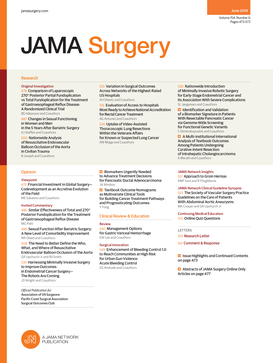Vagus Nerve Preservation for Early Distal Gastric Cancer With Monitoring and Indocyanine Green Labeling
IF 14.9
1区 医学
Q1 SURGERY
引用次数: 0
Abstract
ImportanceRadical gastric cancer surgery can cause functional and physiological disorders due to the resection of perigastric vagus nerves. Few studies have used intraoperative neurophysiological monitoring and indocyanine green (ICG) labeling to preserve the perigastric vagus nerve and to evaluate the corresponding effects.ObjectiveTo assess the feasibility and effects of vagus nerve preservation using neurophysiologic monitoring and ICG labeling during laparoscopic distal gastrectomy in patients with early distal gastric cancer.Design, Setting, and ParticipantsThis open-label, prospective randomized clinical trial initially enrolled 285 patients with clinical stage cT1N0M0 distal gastric cancer from May 2022 to May 2023. This trial was conducted at Qilu Hospital of Shandong University in Jinan, China, and enrolled patients aged 18 to 80 years with histologically proven gastric adenocarcinoma scheduled for distal gastrectomy. The final follow-up examination was performed May 1, 2024.InterventionsEligible participants were randomly assigned 1:1 to vagus nerve preservation distal gastrectomy (VPG) or vagus nerve resection distal gastrectomy (VRG).Main Outcomes and MeasuresThe primary outcome was the incidence of postsurgical gastroparesis. Secondary outcomes included postoperative gallstone formation, quality of life, morbidity, mortality, overall survival, and disease-free survival up to 12 months postoperatively. All analyses were based on both intention-to-treat and per-protocol analyses.ResultsOf 264 patients included in the intention-to-treat analysis, the median (IQR) patient age was 58.0 (52.0-67.0) years, and 67 patients (25.4%) were female. Both the VPG and VRG groups included 132 patients. Postoperative gastroparesis occurred in 1 patient (0.8%) in the VPG group and in 10 patients (7.6%) in the VRG group. Gallstones developed in 0 patients in the VPG group and in 9 patients (6.8%) in the VRG group. As assessed by mean (SD) score on the 30-item European Organization for Research and Treatment of Cancer Quality of Life Questionnaire, the VRG group experienced more nausea and vomiting at 6 months postsurgery (19.38 [7.62]) than the VPG group (17.15 [9.21]) (通过监测和吲哚菁绿标记保留迷走神经治疗早期远端胃癌
重要性 胃癌根治术会因切除胃周围迷走神经而导致功能和生理紊乱。目的 评估早期远端胃癌患者在腹腔镜远端胃切除术中使用神经电生理监测和 ICG 标记保留迷走神经的可行性和效果。设计、设置和参与者这项开放标签、前瞻性随机临床试验从 2022 年 5 月至 2023 年 5 月初步招募了 285 例临床分期为 cT1N0M0 的远端胃癌患者。该试验在中国济南的山东大学齐鲁医院进行,入组年龄为18至80岁,组织学证实为胃腺癌,计划进行远端胃切除术。干预措施符合条件的患者按1:1随机分配到迷走神经保留远端胃切除术(VPG)或迷走神经切除远端胃切除术(VRG)。次要结果包括术后胆石形成、生活质量、发病率、死亡率、总生存率以及术后12个月内的无病生存率。所有分析均基于意向治疗分析和按方案分析。结果 在纳入意向治疗分析的 264 名患者中,中位(IQR)年龄为 58.0(52.0-67.0)岁,67 名患者(25.4%)为女性。VPG 组和 VRG 组均包括 132 名患者。VPG 组有 1 名患者(0.8%)发生术后胃瘫,VRG 组有 10 名患者(7.6%)发生术后胃瘫。VPG 组 0 名患者出现胆结石,VRG 组 9 名患者(6.8%)出现胆结石。根据欧洲癌症研究和治疗组织 30 项生活质量问卷的平均(标度)得分评估,VRG 组患者在术后 6 个月出现恶心和呕吐的次数(19.38 [7.62])多于 VPG 组(17.15 [9.21])(P = .03),而且在 6 个月和 12 个月出现持续食欲不振、反流症状和进食困难的比例也明显高于 VPG 组。结论和意义在远端腹腔镜胃切除术中对早期远端胃癌患者进行神经电生理监测和 ICG 标记以保留迷走神经是安全可行的。保留胃周围迷走神经可保留残胃的功能并改善生活质量。试验注册Chictr.org.cn Identifier:ChiCTR2200059489
本文章由计算机程序翻译,如有差异,请以英文原文为准。
求助全文
约1分钟内获得全文
求助全文
来源期刊

JAMA surgery
SURGERY-
CiteScore
20.80
自引率
3.60%
发文量
400
期刊介绍:
JAMA Surgery, an international peer-reviewed journal established in 1920, is the official publication of the Association of VA Surgeons, the Pacific Coast Surgical Association, and the Surgical Outcomes Club.It is a proud member of the JAMA Network, a consortium of peer-reviewed general medical and specialty publications.
 求助内容:
求助内容: 应助结果提醒方式:
应助结果提醒方式:


